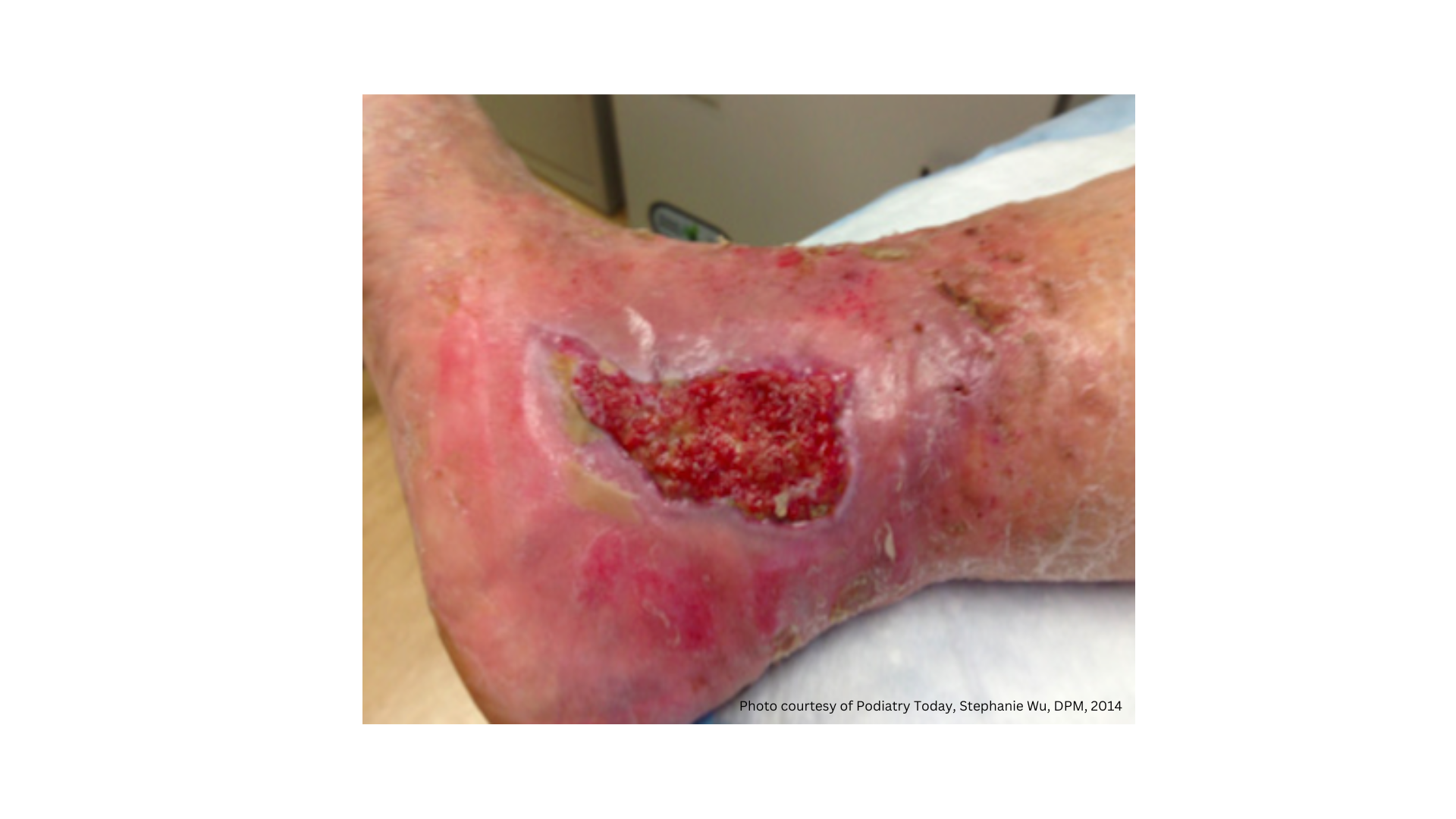Why Wound Hygiene?
December 31, 2022
Introduction
Wounds affect patients across the global health continuum. In 2019, one study found that approximately 2% of the United States’ population has been affected by chronic wounds.1 Proper wound hygiene remains one of the most important tenets to optimize healing outcomes in hard-to-heal wounds. Proper wound hygiene may help reduce the likelihood of infection, accelerate healing times, and decrease the resources required for wound care. This routine could lead to limited health care resources—such as personnel, supplies, time, and effort— being used more effectively.2 In addition, the protocol is suitable for use across multiple wound care professional types and care settings.
Problems in Wound Care Across The Continuum
First, it's essential to understand the problems that wound hygiene aims to solve because although wound healing time and infection rates are often at the top of a wound care professional's mind, there are other factors to consider. For instance, limitations that impact care may include3:
- Follow-up Care: Follow-up care can be more difficult to coordinate when patients are discharged from an inpatient setting. Challenges may include transportation, communication barriers, and outside responsibilities complicating scheduling.
- Resource Limitations: Limited resources may also be available in home and community settings. These limitations may be due to situations related to insurance considerations or a lack of assistance from family or outside caregivers.
- Aging: Aging can limit the ability of a patient to perform wound care, and it impacts the physiologic mechanisms of wound healing. The patient may experience issues with mobility, flexibility to reach the area of concern, or visual acuity.
- Immunocompromise: Immunocompromised patients may experience a greater risk of infection and slower healing times.
- Pain Management: Decreased pain tolerance or hyperalgesia can decrease the patient's forbearance to wound dressings, debridement, or other interventions. This reduced tolerance may lead to a reluctance to attend follow-up visits due to fear of pain.
These factors, among many others, may lead to the development of hard-to-heal wounds and wound care professionals new to the field may wonder why these wounds are so difficult to treat. The following is a discussion of some obstacles to healing clinicians face.
Antimicrobial Resistance
One reason wounds become hard-to-heal is often, although not always, antibiotic resistance. As bacteria become more resistant to antibiotics, it becomes more challenging to clear infections. This factor can prolong healing times and increase the risk of complications.4
The Presence of Biofilm
Antibiotic resistance is often related to the increased presence of biofilm in the wound bed. Biofilm is a community of bacteria that are encased in a protective matrix. This layer makes it difficult for antibiotics and the immune system to reach the bacteria. As a result, infections are more difficult to clear, and wounds are more likely to become hard-to-heal or even chronic.4 The concept of wound hygiene focuses on an antibiofilm approach.2
The Cost of Wounds
The cost of wound care is another factor to consider. Wound care can be expensive, especially when patients require multiple visits or prolonged hospital stays. In addition, depending on the patient’s location or level of insurance coverage, the cost of wound care is often borne by the patient or their family.4 This element can create a financial burden that may lead to nonadherence to treatment recommendations.
Limited Resources
Finally, health resources may have limited availability in some settings, making it difficult to provide the level of care patients need. For example, there may be a shortage of trained staff or limited access to supplies.4 Antimicrobial resistance, biofilm, cost of wounds, and limited resources can all contribute to the development of hard-to-heal wounds. However, wound hygiene practices and principles have been found to bridge the gap.4
The Solution: Wound Hygiene
Wound hygiene is a set of interventions that recommend clinicians cleanse, debride, and dress wounds to prevent and remove infection or any subsequent biofilm. This cleansing practice has been found even to reduce the likelihood of infection, speed up healing times, and decrease the resources required for wound care because wound hygiene is an antibiofilm intervention method.2 This term means that the protocol can help remove and prevent biofilm from forming in the wound bed. This intervention is achieved through the following methods 2:
- Cleaning the wound bed and periwound skin
- Debriding the wound bed (mechanically, biologically, or chemically)
- Refashioning the wound edges
- Dressing the wound
Use Across Various Settings
Wound hygiene does not require special training or expensive technology, making it accessible and easy to implement across multiple care settings, from hospitals to home care.2 Wound hygiene practices can often be carried out with standard tools available in the clinic, such as scalpels and cleaning agents. Although specialized dressings that optimize moisture levels in the wound bed can be used, it may be necessary to chemically debride the wound or absorb exudate. It is possible to train staff of varying levels to perform wound hygiene
For example, in hospitals, wound hygiene can be completed by a multidisciplinary team, often including nurses, physicians, physical therapists, etc. In home care settings, however, it may be more feasible for a caregiver or home health nurse to complete wound hygiene techniques since they may see the patient more regularly.
Barriers to Implementation
Despite the many benefits of wound hygiene, clinicians may find barriers to its integration into standard of care. The most common barriers include confidence, the desire for more research, and competence. Lack of confidence in the protocol is reported as a barrier to the adoption of wound hygiene by 39% of applicable clinicians.5 This barrier may be due to clinicians' unawareness of recent consensus documents on wound hygiene practices put together by leaders in the field.4 These documents provide guidance on best practices for wound care and can help increase confidence in wound hygiene protocols.
Other clinicians, though, are aware of the research supporting wound hygiene but want to see more of it before they are willing to adopt it in clinical practice. This statistic is reported as a barrier by 25.7% of clinicians.5 New technologies and interventions often go through a period of research and development before they are widely adopted, which can be a lengthy process.
Competence is reported as a barrier by 24.8% of clinicians, which refers to the skills and knowledge required to complete wound hygiene effectively.5 For example, some wound care professionals may feel they need to be more competent in their ability to cleanse and debride a wound bed correctly. Others may not be able to apply a dressing or refashion a wound edge. Competence can be improved through education and training. However, it may not be feasible for all levels of staff because certain aspects of the protocol, like debridement, may require certification.
Certifications for nurses performing debridement vary from state to state. For example, in Ohio, registered nurses can perform conservative sharp wound debridement with a physician's order.6 In contrast, Alabama requires registered nurses to take a course and perform supervised practice before completing sharp debridement.7
Conclusion
Despite barriers to adoption, wound hygiene is a vital part of wound care. With the rise in antibiotic resistance, wound hygiene provides a new and practical method of infection prevention. Not only may it help prevent infection, but wound hygiene practices may also speed up healing, especially in vulnerable populations. Additionally, it can be used across a range of settings, making it a strong choice for hard-to-heal wounds. Wound hygiene is an essential part of wound care, and it behooves wound health professionals to be trained in its implementation.
References
- Sen CK. Human Wounds and Its Burden: An Updated Compendium of Estimates. Adv Wound Care (New Rochelle). 2019;8(2):39-48. doi:10.1089/wound.2019.0946
- Murphy C, Mrozikiewicz-Rakowska B, Kuberka I, et al. Implementation of Wound Hygiene in clinical practice: early use of an antibiofilm strategy promotes positive patient outcomes. J Wound Care. 2022;31(Sup1):S1-S32. doi:10.12968/jowc.2022.31.sup1.s1
- Atkin L, Bućko Z, Montero EC, et al. Implementing TIMERS: the race against hard-to-heal wounds. J Wound Care. 2019;23(Sup3a):S1-S50. doi:10.12968/jowc.2019.28.sup3a.s1
- Murphy C, Atkin L, Swanson T, et al. Defying hard-to-heal wounds with an early antibiofilm intervention strategy: wound hygiene. J Wound Care. 2020;29(Sup3b). doi:10.12968/jowc.2020.29.sup3b.s1
- Murphy C, Atkin L, Hurlow J, Swanson T, de Ceniga MV. Wound hygiene survey: awareness, implementation, barriers and outcomes. J Wound Care. 2021;30(7):582-590. doi:10.12968/jowc.2021.30.7.582
- Interpretive Guideline. Ohio Board of Nursing. Published March 17, 2021. Accessed December 3, 2022. https://nursing.ohio.gov/wp-content/uploads/2021/04/Guidelines-for-Cons…
- State by State Summary. Advanced Wound Debridement. Accessed December 3, 2022. https://www.sharpdebridement.com/state-by-state-summary
The views and opinions expressed in this vlog are solely those of the author, and do not represent the views of WoundSource, HMP Global, its affiliates, or subsidiary companies.
The views and opinions expressed in this content are solely those of the contributor, and do not represent the views of WoundSource, HMP Global, its affiliates, or subsidiary companies.








